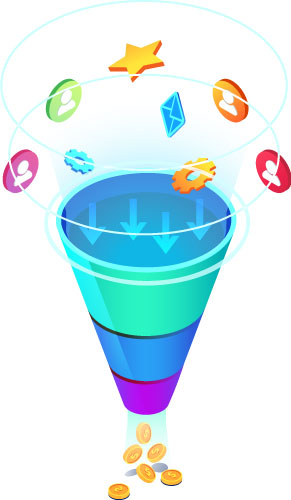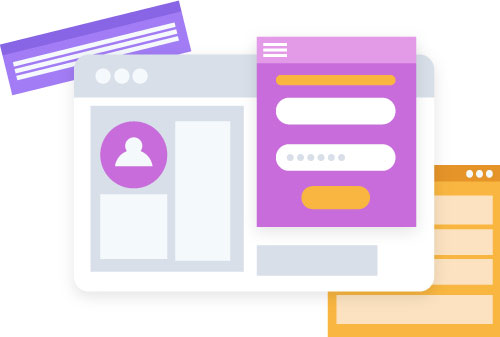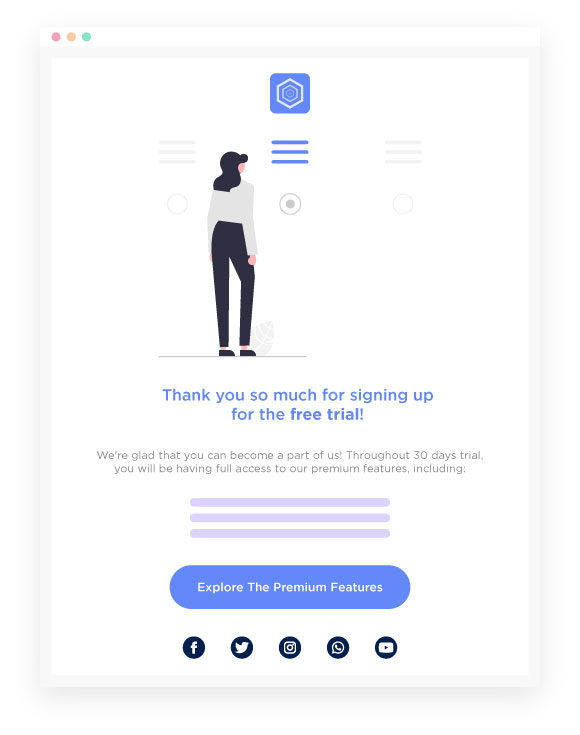Today nurturing lead has become important like never before. Businesses are investing and striving to develop relationships with their customers. Therefore, to help you out, we have come up with a guide on lead nurturing, where we will be discussing all lead nurturing, its benefits, and strategies to implement.
Contents
What is Lead Nurturing?

Lead nurturing is a means of building relationships with potential buyers and driving them down your sales funnel.
Lead nurturing lets companies guide their prospective customers towards buying by solving questions, explaining how to overcome challenges, and putting the product as the ultimate solution to their primary problem.
Your consumers can not reach your site ready to purchase instantly, so you need to have a system for taking them from where they are in their customer journey and encouraging them to move forward.
With the help of lead nurturing, you can reach out to your consumers via various touchpoints and give them the information they require to move on to the next stage of the Buyer’s Journey.
Why Is It Important?
Before we move ahead and learn how to nurture leads, we need to understand why to lead nurturing is so essential for the success of your business.
As per the statistics, on average, 50% of the leads in each system are not yet ready to purchase.
If you sell to those willing to buy and ignore the rest of your leads, you’re diminishing your potential revenue by half.
Apart from that, lead nurturing is an excellent strategy for companies who desire to grow their sales without expanding their marketing budget.
According to Forrester, businesses who do lead nurturing precisely can produce 50% more sales at a 33% lower cost.
You need to know some of the benefits before we move forward and learn lead nurturing strategies.
Some of The Best Lead Nurturing Benefits
Lead nurturing has a lot of benefits. Its importance has been recognized worldwide as a powerful technique that allows the marketer to improve the number of sales they make in a provided period. Some of the lead nurturing benefits are:
1. It Can be Automated
You do not have to track the lead manually. All you need to do is to set up the automation. Then, the system observes what the lead is involved in, giving you comprehensive reports and nurturing them without requiring you to make an effort.
2. It Helps You Manage and Grow Relationships
Automated lead nurturing enables you to manage the relationship between your business and the lead and encourages you to increase this relationship. ‘Thereby leading to a possible rise in the likelihood of turning your prospect into a customer.
3. It is Targeted
Lead nurturing does not just give random and irrelevant information to the lead. Instead, it monitors the lead and presents targeted content that customers are interested in.
4. It Saves You Money
Automated lead nurturing is more affordable than direct email messaging. In addition, it assists in saving the money you spend on keeping up with your possible customers.
So coupled with all the above advantages, automated lead nurturing is pocket-friendly. This is because it is largely automated, and you do not have to pay human resources to maintain it.
5. It Can Lead to New Leads
Lead nurturing not only handles existing leads but also does new lead generation. For instance, satisfied customers speak about good (and bad!) experiences with companies, and word of mouth and referrals are among the most efficient ways of producing new leads.
Moreover, if your content is shareable and engaging, your leads are likely to share it with others with the same interests, leading to a new prospect for you to engage with.
6. Higher Click-Through Rates
A study on more than 2,400 companies was carried out utilizing mass email marketing or lead nurturing. It was found that the lead nurturing approach experiences higher click-through rates.
In addition, it was observed that lead nurturing emails also had a somewhat higher unsubscribe rate than individual email sends. It can be viewed as a negative performance, but it is a sign of nurturing to confirm leads and eliminate people who are unwilling to do business.
7. Lead Nurturing is Timely
Lead nurturing is different from random email distribution because it is timely. It reacts instantly to potential customers and doesn’t waste any time in building a relationship.
Whenever a customer notices that the company is so involved in forming a relationship with him, there is improved motivation to do business with that company, leading to enhanced company sales.
8. It Lets You Discover Cross-Sell and Up-Sell Opportunities
While dealing with former customers, lead nurturing provides a way to improve that customer’s awareness of your company’s offers.
Moreover, the study found that nurtured leads have a 9% higher average deal size; this indicates a potential to improve the number of sales you have, but can also enhance the value of sales utilizing lead nurturing.
Top Lead Nurturing Strategies for Your Business
1. Know Your Buyer Persona

First, you have to define your buyer persona; if you have not decided yet, then the time has come. When you have a clear understanding of your buyer persona, it allows you to recognize better who is and isn’t the right lead.
Also, focusing on your buyer persona will let you decide which lead is worthy of your time and what sort of content and interaction they will respond to best.
It would be best to determine your buyer persona with your sales team to be also clear on who they should be communicating with.
2. Coordination between Your Marketing and Sales Teams
We all know that every department has different roles, operations, and styles, but they both are ultimately working towards the same goal. The lead nurturing campaign aims to bring your marketing and sales teams on the same page.
If these departments understand each of their respective ends and allow distinguishing relevant leads, then your prospect nurturing should start to excel.
It is also recommended to use a shared tool so that both teams can view all of the important information about every lead. For instance, although knowing when and how to drive leads along the funnel is important, it is also important for both teams to have eyes on the leads.
3. Design and Send Segmented Content
We all have heard that content is king. Also, if the content is king, then its backbone is personalization.
Personalization can take your prospects to the following level as it makes your leads feel different, appreciated, and as if you are individually reaching out to them.
Make sure you segment your content so that every phase of the buyer journey gets content relevant to where they are in the conversion funnel.
You can go still further by then segmenting the very conversion stage content to distinct demographics. The more personalized your message is, the more valued your audience will feel.
4. Set The Customer Journey

Once you determine your buyer persona, you can now work on the buyer journey. The buyer journey is actually how your potential customer goes down the conversion funnel.
While preparing to participate in inbound lead nurturing, specify what sort of communication or content you will deliver to the lead as they proceed down the sales funnel. You don’t need to do much soon because it may come across as too pushy.
5. Track Interactions in Real-Time
You have to make sure that you deliver the correct message at the appropriate time is a fundamental aspect of inbound lead nurturing.
Addressing certain messages, like a welcome email when someone signs up for your service or a reminder email whenever someone abandons their cart, can make a huge difference while introducing yourself to a lead or re-engaging them.
Timing can be very precarious at the start of the buyer’s journey. However, you never need to request too much information from your leads or risk them not taking you.
6. Utilize Smart Forms

It is important to obtain information about your prospects so that you can categorize them properly. But, getting sufficient information from your leads can be a little tricky sometimes.
This is where smart forms come into the picture. Smart forms can identify the user when they are inscribing in their information and populate various questions.
This means that the more users involved with your website and content, the more data you can progressively collect on them.
Thus, smart forms end up being both useful for the company and the user, as it enables you to discover more while they aren’t stuck answering the same questions repeatedly.
7. Automate Your Communication
If you are considering lead nurturing tactics for the first time, it can seem like a lot of work from the start. And it is – except you automate your process. But, sadly, a proper lead nurturing approach needs to be automated to be productive and effective.
Employ a marketing automation tool to build message sequences that send out your content and information. You can add these tools to send out the right content to the right leads at the appropriate times.
Not only does this take the burden off your marketing and sales teams back, but it also assures that none of your leads unexpectedly get left behind.
8. Multi-Channel Lead Nurturing
Whenever marketers study leads nurturing, they consider it about email marketing. But the procedure can happen through many various marketing channels.
As per the research, they are remarketing ads on Google and social media can be a magnificent opportunity for e-commerce or online stores, particularly when a potential customer has dropped their cart.
Moreover, uploading your database into those platforms will recognize your leads and send them personalized ads. Ebooks, downloadable resources, and Webinars can also be valuable content.
9. Optimize Your Welcome Email

When it comes to lead nurturing, first impressions usually take place by a welcome email.
According to stats, welcome emails have an open rate of 57.8%, compared to 14.6% for other kinds of emails. When emails are conveyed in real-time, this figure rises to 83%.
It is recommended to include the following in your welcome email:
- Thanks: You should always be polite and thank your lead for signing up in your email database.
- Explanation: A welcome email is a great time to explain what you do and what sort of content you’ll be sharing with them
- Extra Content: While they’re already involved, recommend some personalized content that could engage them.
- A CTA: They’ve opened your email, now what do you desire them to do? Include a Call-to-action in your email to urge them to take the next step, whether a store on your online store, subscribe to your YouTube channel, etc.
- A Farewell: It never harms to be extra nice!
10. Design Custom Offers

The most reliable lead nurturing strategies involve a method of getting a lot of information about your leads. When a lead is willing to convert, utilize all of that important information to boost the likelihood of conversion. Send them a proposal that’s difficult to resist, like a free trial or discount.
11. Measure the Interactions Throughout the Process
When you send out information, the leads interact with them. These communications should determine your next actions. Your prospect’s communications with your content should be covered in your lead scoring process or algorithm.
Once they have attained a certain score, they get assigned the next “level” of content until they finally reach a score that symbolizes they are ready to be transferred to your sales team.
12. Follow Through
You may have heard that it is cheaper to keep an existing customer than obtain a new one. So while the method may be called inbound lead nurturing, that doesn’t indicate the relationship you’ve formed ends once the sale has closed.
Make sure that the relationship you’ve developed with your customers stays solid. Consumer service check-ins and loyalty emails are two methods to make sure that the lead you struggled so hard to get remains a customer for life.
Wrapping it up
In this guide we all have seen all about lead nurturing and why it is important and what benefits you will get when you apply it. There are some tried and tested strategies that you can follow to give it the best shot.
Read more:

























 Email
Email SMS
SMS Whatsapp
Whatsapp Web Push
Web Push App Push
App Push Popups
Popups Channel A/B Testing
Channel A/B Testing  Control groups Analysis
Control groups Analysis Frequency Capping
Frequency Capping Funnel Analysis
Funnel Analysis Cohort Analysis
Cohort Analysis RFM Analysis
RFM Analysis Signup Forms
Signup Forms Surveys
Surveys NPS
NPS Landing pages personalization
Landing pages personalization  Website A/B Testing
Website A/B Testing  PWA/TWA
PWA/TWA Heatmaps
Heatmaps Session Recording
Session Recording Wix
Wix Shopify
Shopify Magento
Magento Woocommerce
Woocommerce eCommerce D2C
eCommerce D2C  Mutual Funds
Mutual Funds Insurance
Insurance Lending
Lending  Recipes
Recipes  Product Updates
Product Updates App Marketplace
App Marketplace Academy
Academy

